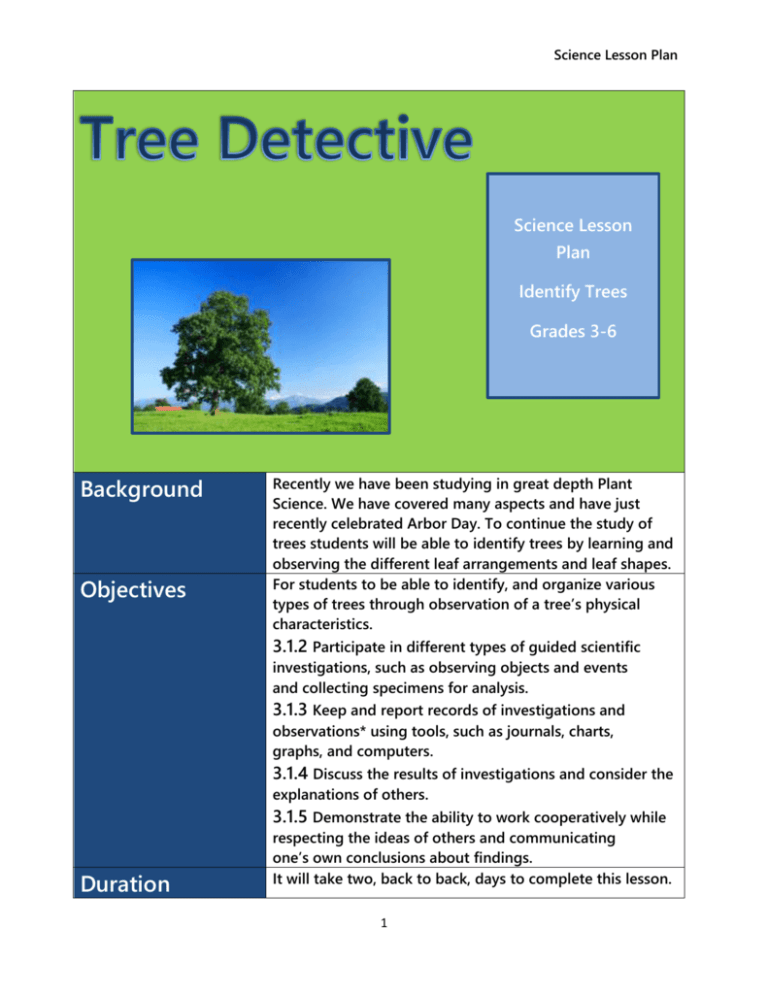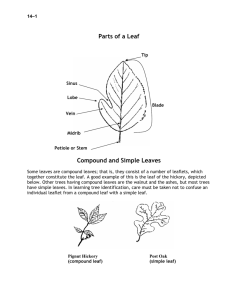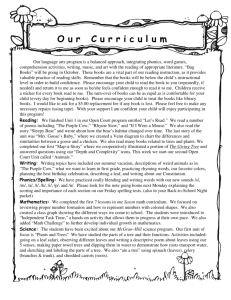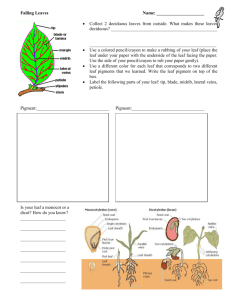Tree Detective
advertisement

Science Lesson Plan Science Lesson Plan Identify Trees Grades 3-6 Background Objectives Recently we have been studying in great depth Plant Science. We have covered many aspects and have just recently celebrated Arbor Day. To continue the study of trees students will be able to identify trees by learning and observing the different leaf arrangements and leaf shapes. For students to be able to identify, and organize various types of trees through observation of a tree’s physical characteristics. 3.1.2 Participate in different types of guided scientific investigations, such as observing objects and events and collecting specimens for analysis. 3.1.3 Keep and report records of investigations and observations* using tools, such as journals, charts, graphs, and computers. 3.1.4 Discuss the results of investigations and consider the explanations of others. 3.1.5 Demonstrate the ability to work cooperatively while Duration respecting the ideas of others and communicating one’s own conclusions about findings. It will take two, back to back, days to complete this lesson. 1 Science Lesson Plan Materials 25 different kinds of tree leafs, leaf clue sheet, pencils, area that has a variety of trees, 10 internet accessible computers, and an ELMO or overhead projector. Procedures Day One Grabber: Have 5 leafs hanging on the chalkboard. Ask the students, what differences can you see by looking at these leafs? What similarities? Each of these leaves represent a different kind of tree, (write name of tree under leaf) but how can I know what leaf goes with each tree? There are certain characteristics we must observe to be able to correctly match a leaf with a tree. We must first see how the leaf is attached to the branch. Does it alternate leafs (show an example under ELMO) or are they opposite of each other (show example compared to alternating example). Then we must decide if it’s a simple, compound, or doubly-compound leaf (show examples of each). Finally, we need to look at the leaf shape: Entire, Singly-toothed, Doubly-toothed, Lobed, and if it has a Leaf Clasp (show examples as you say each one). Procedure: Now, this does sound like a lot to remember and consider but when we are actually looking at trees in their habitat it is not so hard, which is what we will be doing. We are going to go to the Tree Park behind the school and you will have a leaf clue sheet that will help you organize and remind you of every characteristic you need to observe. Now, each tree will be numbered and you will write down what characteristics that it has. (Day two we will have a chart that we will look at to figure out what kind of tree it is by applying the characteristics we found out about it.) Once outside help children by asking questions such as, Does this tree have alternating arrangement of leaves? What does an entire leaf look like? When back in the room go over what characteristics were recorded for each tree, compare answers to ensure that everyone has the correct identification. Also, help clarify if 2 Science Lesson Plan there are mistakes in the recordings. End the lesson by reviewing the different characteristics by asking questions like, how can we tell if it is a lobed leaf? Or can someone come to the board and point to a doublycompound leaf? Day Two Procedure: Review what was covered the day before. Use the Chart to identify what kind of tree goes with each leaf, this work should be done individually. After this, split the room into four groups and have them compare answers and reason with each other on how they concluded their decision. Next, explain that each of the 9 computers is labeled for what information will be entered in each (alternate, opposite, entire, singly-toothed, doubly-toothed, lobed, leaf clasp, compound, and doubly-compound [each computer should be clearly and boldly labeled].) On each computer a project page will be opened on Vitalist and the title of the page will be one of the 9 characteristics. For every characteristic a tree fits under, a group representative will type the name of the tree in a list format (each group will have 5 different trees to be in charge of correctly categorizing on the site). Once all trees are entered, the group representative will save and send it to the teacher’s e-mail (the e-mail should already be filled in). The teacher will combine the list, through Vitalist, and then open it up through the ELMO, viewing the information in a clear way. Go over the findings and understand what it means. Review again the different characteristics and have a short quiz to assess the students understanding. Assessment Quiz the children on the different characteristics by having them draw the 5 different shapes of leaves, write down the different possibilities for leaf arrangement-alternate and opposite, simple, compound, and doubly-compound. 3 Science Lesson Plan 4








